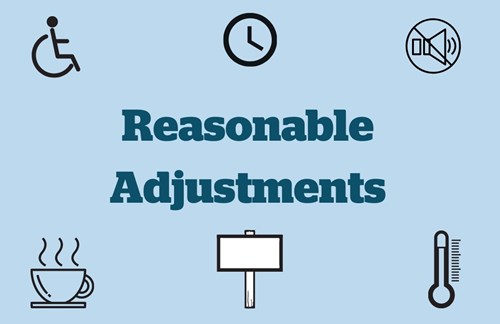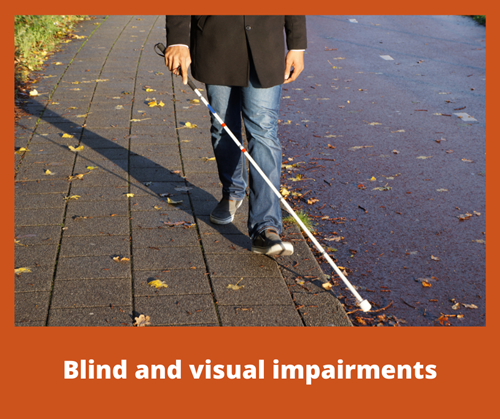Reasonable adjustments

Introduction
In the UK, it is estimated that there are approximately 14.1million people who have some form of disability or are living with a long term health condition, 4.4million of whom are currently in employment.
In order for disabled people to be able to get out and about, carry out everyday activities or go to work, they may need additional support or some reasonable adjustments to be made. The level of support or adjustments needed, will of course vary, depending upon the individual.
Although more than 4.4million disabled people are currently in employment, they’re more than twice as likely to be unemployed, as non-disabled people.
Family Resources Survey 2019 / 20
Have you made reasonable adjustments?
Under the Equality Act 2010, businesses and organisations have a legal duty to make ‘reasonable adjustments’ that will allow disabled people, including customers and employees, to access the same opportunities and services as non-disabled people.
These can be small adjustments, such as turning down background music or making a location or environment more accessible and inclusive for everybody.
The act recognises that solutions may vary, according to individual circumstances, and offers simple criteria that any proposed adjustment must be…
- Effective
- Practical
- Significant
The duty to make reasonable adjustments in goods and services is anticipatory. This means a business or service provider must not wait for a disabled customer to ask for something to be done, they should consider in advance, what they need to do, to make their services accessible to all disabled customers and employees.
These could include, but are not limited to…
- Physical features: Accessibility of your building and environment, ramps, lifts, parking, toilets, meeting spaces, break out rooms, easy read or high visibility signage.
- Provision of auxiliary aids: Hearing loops or assistive technology.
- Provisions, criteria and practices: Equal opportunity policies, improved workplace culture, customer service provisions, staff support systems or flexible working practices.
The Equality Act also includes general examples for employment, such as…
- Adjusting premises
- Acquiring or modifying equipment
- Altering a disabled person's working hours
- Allocating some of a disabled employee's duties to another person
- Allowing absence for rehabilitation or treatment
- Arranging or giving extra training
- Providing supervision
When starting a new job, disabled people stated that the most effective and positive approaches were demonstrated by employers and staff, which...
- Embraced reasonable adjustments, such as accessible working schedules and working from home
- Fought the disabled person’s corner, including support during Access to Work complications, long time delays getting equipment and being supportive of recommendations made by occupational health services
- Were clearly approachable, understanding and open to suggestions
- Thought of practical solutions when faced with issues such as access and making adjustments to provide equality
A positive approach to a disabled person’s requirements and practical applications of good practice, can make a massive difference when employing disabled people and can be a huge step towards creating equality in the workplace.
Scope Our Lives, Our Journey Executive Summary
Top tips!
Don’t forget to consider the following…
- Do not make assumptions! Get to know your customers or employees, as they will be able to tell you what will work best.
- Can a disabled person safely and independently move around your venue / space?
- Does your physical environment have steps, narrow or cramped spaces, shiny floors, confusing signage or high / low temperatures?
- Do you have any potential areas of sensory overload, such as too much noise or bright lights?
- How do you communicate with customers and employees? Are you welcoming and clear and can you adjust this for different situations, if necessary?
- Have you taken into account any time factors, such as is the allotted appointment time enough?
- Look at your work structures and policies, are they equitable and disability friendly?
- One size doesn’t fit all, so you may need to consider various adjustments for different situations and individuals. Take a look at Clear Talents for additional information and guidance, it’s suitable for employers and employees.
1 in 3 disabled people (32%) feel there is a lot of prejudice against disabled people, compared to only 1 in 5 non-disabled people (22%).
1 in 3 people (32%) think disabled people are not as productive as non-disabled people.
Scope Disability Perception Gap Report 2018
Start making your reasonable adjustments today!
To find out more about the reasonable adjustments you can make, for a range of different health conditions, disabilities or for those who look after someone else, download the free, handy infographics from Healthwatch Herefordshire, which cover...








Please note...
Hidden disabilities includes asthma, cancer, diabetes, dyslexia, epilepsy, HIV / AIDS and migraine.
Physical disabilities includes arthritis, cerebral palsy, mobility impairments, multiple sclerosis and obesity.
